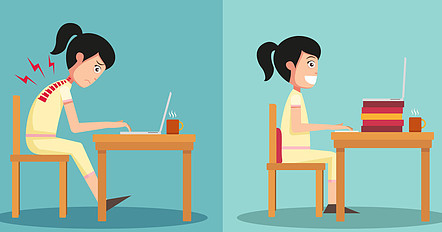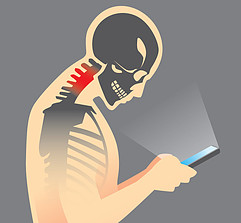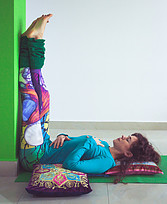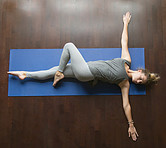The reason you would want to know how to improve balance and symmetry, is because they are required for your optimum health. Collapsed posture impedes this ultimate goal. With the increased use of technology in the last generation, and heightened during the pandemic, we observe how this increased use has affected posture.
Collapsed Posture
Laptop and especially smart phone use has increased. Watch someone while standing or walking down the street while they are texting. See the shoulders rolled forward? The neck is extended out and the head tilted down. If the person is also walking the stride is shortened and erratic. This is then repeated many times per day. While performing this action, the posture is temporarily collapsed.
What is the response to this collapsed posture? The tissue surrounding the muscle fibers, tendons and ultimately attaching to the bones in the joints is called fascia. The fascia or connective tissue, is a pliable collagen based tissue with an oily fluid to keep it flexible. This fascia also has its own nerves called fibroblasts. Fascia responds to trauma, and to posture positions held for extended periods of time, by thickening and becoming less pliable. The fascia gives support to the new posture or rolled forward shoulders, extended neck, head looking down, and hips having less rotation.
We now have a new human posture. It supports the function of texting and computer work, but makes it more difficult to move through space with ease. When exercise is attempted, pain signals are sent to the brain, because the connective tissue is so dense at the attachments, moving becomes more difficult.
Fascia Thickening Affects Balance And Symmetry
How does the thickening of fascia affect balance? In the example above where the person is texting while walking we observe the neck extended and the head looking down. The center of gravity has changed. Our head, on average, weighs 11 to 12 pounds or 4 – 5 kg. The 7 cervical vertebrae in our necks are the support system. If your head is forward and looking down just one inch, about a 15 degree tilt forward, the gravitational strain on these vertebrae more than doubles to about 27 pounds. 
The person in our example, fully into texting, has a 60 degree tilt and 60 pounds or gravitational strain! That’s 5 times the weight of the head! The fascia’s nerves, the fibroblasts, sense this as a trauma. They thicken all the attachments to compensate for the strain. If this issue happened once in a while, for a short time, the pattern would return to homeostasis, which is the normal healthy balanced state of being. Do it on a daily basis, several times a day and the pattern become entrenched.
This person will have a more difficult time turning the head and standing up straight. Pain will be a constant companion. We haven’t even talked about the shoulders or hips yet. The same process is going on in the shoulders, where there is little structure at all! The shoulder basically just floats with only soft tissue holding it. Rolled forward shoulders has an even more immediate change in pattern than the neck, because of the lack of structure supporting it. Now this person not only has neck problems, but can no longer throw a ball to their dog or child and even placing a dish on the top shelf becomes a major chore! This person now has a balance issue as well, because the head and shoulders are forward, the center of gravity is off and falling becomes a regular issue. Serious injury ahead is a strong probability.
How To Improve Balance and Symmetry
If you have chronic pain, and you’ve gone to your doctor and they take Tylenol and rest or give you muscle relaxers, then you likely have fascia thickening, which I like to call bundling. In my clinic, I work on these problems every day. I smooth out and lengthen the fascia with a combination of vibration, manual tissue manipulation with my fingers, traction and light stretching.
There are things you can do on your own, without going to someone like me. The fascia is bundled up. Because its thickened at the joint attachment, (that same tissue is what surrounds the muscle and tendon, and every muscle fiber), the muscle is now shortened, or feels like it is. we need to lengthen the fascia, communicate with it and show it where homeostasis is. Overstretching can actually make it worse. The stretches to do are at the first edge, where you just barely start to feel the stretch.
If the problem is in the shoulders or you feel pain or tension mid to upper back, roll up a towel into a fairly tight cylinder, Place it on the floor and lay on it so it is perpendicular to the spine at the bottom of your shoulder blades or scapula, where a bra-strap might be. Lay on it 3 minutes with your arms out, elbows bent palms up and fingers pointing above your head. I like to call this cactus arms. It takes 3 minutes for the fascia to adjust to this new position. I refer to it as rebooting the fibroblasts. It’s like tuning your computer off, then back on. It dumps the old data and starts fresh.
For you to find relief for your neck is a little more difficult. However, there is a product that is easy to use and fairly reasonably priced called a neck hammock. Follow the instructions. Use the “Neck Hammock” 10 minutes a day to reset all those hours of computer work. You will be happy you did!

Hip Issues
Hip issues are more complex. There is a couple of safe passive stretches you can try, Legs up the wall is relieving for the low back, and tight hamstrings, which can affect the hips.

Another safe passive stretch is a one legged twist. 2.5 minutes here will relieve upper gluteal region pain and hip tightness.
Conclusion
This information is meant to be informative and not diagnostic. If you have chronic pain, check in with your doctor before trying anything I have recommended here. Sharp pain is not acceptable in any of the modalities I have offered, stop immediately and take a stroll. Are you still hurting after the modalities? Check in with your doctor.
Fascia issues are prevalent. I hope this article has improved your awareness.
Be well, and to your optimum health!
Al Perry

This is great information, especially for the times that we live in, because our habits are affecting our health, and unless we are aware and make changes now, we are going to suffer later with pain and stiff bodies.
It is not so easy to think about your posture all the time, especially when you are only thinking about work, or only thinking about what you are going to say to a friend when you text them, but the exercises you have given will help to make one more aware in the future, because as you exercise the relevant muscles, you will feel what feels right and wrong on your body.
Thanks for reading and commenting, Michel…
I’m happy you’ve found the article useful.
I’ll be posting more easy stretches for relieving entrenched patterns from our diligent work online.
Be well and thrive!
Al
I think this article is meant for me. I have really bad posture. I never sit up right. I am always slouching. I know that it is bad for my back but I still do it. It’s because sometimes I forget that I am actually doing it. I will take this article into account and try out your methods.
Glad to hear you resonated with the article, Daniel!
Please keep me posted on how that works for you.
I may have some other pointers as you progress. You’ll be grateful you caught this, because as you age, this will be much worse for you.
Keep it up, stay strong and thrive!
Al
Hey Al, thanks for writing this very informative article. I really enjoyed reading it! I have also seen an increase in hyperkyphotic posture at our clinic since the pandemic started. I fully believe that as health professionals we are going to have to place more emphasis on educating our clients on the necessity of maintaining an ergonomic workspace as more individuals work from home. I find standing desks to be very helpful, but I also encourage my clients to text looking straight forward and elevating their phones, as well as taking frequent breaks to stretch and stand with their backs to a wall. Keep up the great work! I will look forward to reading more authoritative articles from you in the future.
Thanks, Ian, for reading and commenting!
True, we need to educate our clients, family, friends and patients.
Yes, standing desks are helpful!
Best to you! Be well and thrive!!
Al
Good posture is something that we all should thrive for to main good health, it is amazing in this day and time how so many persons have bad posture whether sitting down or standing up and the amazing thing is that people have these bad postures because of habit that are developed overtime even stemming from our childhood. Thank you so much for sharing.
Thanks for reading and commenting, Norman!
This blog has a lot if good information. I know how it feels when your are hunched over the laptop for hours on end. The Neck Hammock will come very handy to relax those neck muscles. I suffer from hip issues and like the exercises pointed out in your blog. I enjoyed reading your blog it was very informative.
Elke
Thanks for reading and commenting, Elke!
I hope you try the neck hammock, it’s very helpful!
And for your hips, legs up the wall every night! OK?
Be well and thrive!!
Al
Thank you very much for this article. We have been working from home during and after the pandemic. Spending hours at our laptops, tablet, and cellphones. And I have started to note I’m developing a bad posture. I have also seen many people around me with their shoulders rolled forward when checking their devices. Bad posture seems to be another epidemic. Thank you very much for this information. I will take action based on what you explained here.
Good for you, Paolo!
Thanks for reading and commenting!
You’ll improve your posture and your health!
Stay strong and thrive!
Al
This blog is a timely post for me. I sit working on a computer most of the day, and I notice my posture is not good.
Just reading your blog made me sit up a little taller. The neck hammock sounds like just what I need, a slight stretching at the end of the day.
Thanks for reading and commenting, Sharon! I’m certain you’ll find that the Neck Hammock is helpful!
Stay well and thrive!
Al
The more I read, the more I realized that I was setting myself up for more discomfort than I was trying to avoid by slouching, or having a collapsed posture as you put it.
I broke my hip in the army, it is fine now, but on top of the posture penalties I have racked up against myself from tech use, I got accustomed to adjusting the way I sit to avoid any inflammation in the areas of my injury. I do still have pains from time to time, but the real problems are starting to present themselves in the form of shoulder and elbow pain from resting my arms on the nearest object as I type (I am LAZY at times), back pain, and knee pain as I constantly sit on my legs and hold myself in awkward positions when I work from the couch.
I need to do something about this, and I am glad I found your article to help me understand the damage I was doing on a factual level.
I have often considered getting a standing desk to help with exactly this, but I just haven’t moved forward with it yet and I am not sure why. Do you think having a desk that is high enough for me to look eye-level at a screen and hold me in typing posture as well could help me regain some of my natural movements back?
I will also be implementing some of the techniques you suggested to relieve pain and attempt to restore balance and symmetry.
Thank you, great stuff!
Thanks for reading and commenting!
Standing desks are a helpful tool! In the meantime, set an alarm on your timer to get up and move..
I deal with issues from old injuries often in my practice. Find someone who does myofascial release in your area to break up that bundled tissues from your injury.
Stay well and Thrive!
Al
Hi Albert, The main reason why good balance is so important for us is because it makes movement easier and reduces falling—especially among older adults with lower bone mass.
As you know, falls are the leading causes of traumatic brain injuries, and one out of five falls results in a serious injury. When we improve our balance and symmetry, we’re not only working the often-neglected stabiliser muscles; we’re also improving our joint stability and internal focus.
In my opinion, stretching and Yoga exercises can significantly improve our balance and symmetry. Thank you so much for sharing a very informative article about balance and symmetry. Much appreciated.
Thanks for reading and commenting!
Yes, stretching and yoga can be good health partners if done correctly. Unfortunately, my healing practice is filled with injuries from folks trying to do good things for their bodies, but did them unsafely.
Better to get guidence before attempting an exercise, even stretching, off it’s new to you.
Stay well and strong!
Al
So many of us don’t realize the importance of having good posture really is. It is the most simple to fix but highly overlooked when it comes to our overall health.
This is especially as we get older. And I admit that I’m guilty of this as well when sitting at my computer desk for hours slumped over and when I finally get up I’m still.
We tend to overlook these articles until we actually need something fixed on us.
Thanks per reading and commenting, Johnny…
I hope the article plays a small part in you’re overall good health!
Stay well and Thrive!
Al
This is a very important and helpful article indeed, so many people are out of balance in our world today. I knew about this but never in this much detail as you showed here, I shared this article because I love it so much and I know many people would find it as helpful as I did
Thanks for reading, commenting and sharing. Stay balanced!
Stay Well and Thrive!
Al
Thank you for this blog post on how to improve balance and symmetry. I have been having neck issues, and even had a neck hernia in the past, so I am always looking for preventive things and things that can help with my issues. The neck hammock seems interesting to give my neck a rest and I hope I will do better now when having worked on a computer all day, thanks!
Thanks, Lizzy, for reading and commenting.
The neck hammock is a wonderful tool to have and use to combat text and computer neck. Both activities are very hard on our hard working necks.
I hope it brings you some relief!
Stay well and Thrive!
Al